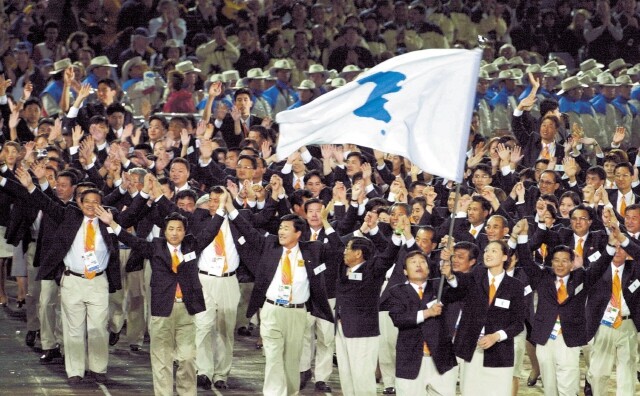hankyoreh
Links to other country sites 다른 나라 사이트 링크
Attention focuses on joint entrance for Korean athletes at Pyeongchang Olympics

Given the increasing likelihood that North and South Korean athletes will march into the stadium together at the opening ceremony of the Pyeongchang Winter Olympics in 2018, attention is focusing on the format that the march will take, including the uniforms, anthem and flag bearers.
The first time that North and South Korea made a joint appearance on the international sports stage was at the 2000 Summer Olympics in Sydney. “Korea” was chosen to be the name of the inter-Korean team of athletes at those games. The banner under which the Korean athletes marched was the Unification Flag, and their anthem was “Arirang.”
That was the first of nine international sporting events that North and South Korea marched into together, with the final event being the 2007 Asian Winter Games in Changchun, China. The athletes carrying the Unification Flag have rotated between pairings of a South Korean woman and a North Korean man, and a North Korean woman and a South Korean man. At Pyeongchang, the athletes carrying the flag will be a South Korean man and a North Korean woman.
The anthem is prepared for the joint entrance into the stadium and for any medals won by a unified inter-Korean team. At the Pyeongchang Olympics, North and South Korea, being the hosts of the games, will march together into the stadium last of all, and “Arirang” is likely to be the song best-suited for the shared sentiments of both halves of the peninsula. It would not be feasible to create a unified team for these games.
The uniforms to be worn when North and South Korea march into the stadium together are a tricky issue. For one, the South Korean Olympic athletes’ outfits and gear have all been made already, including their shoes and their uniforms for the opening and closing ceremonies and for the award ceremony. If North Korean athletes march with their South Korean counterparts into the opening and closing ceremonies together, it would make sense for the North Korean athletes to coordinate their uniforms with those of the more numerous South Korean team. That would require an agreement with North Korea.
The uniforms for the opening and closing ceremonies are long coats stuffed with duck-down, with a taegeuk symbol over the heart and “Team Korea” written in calligraphy on the outside of the right arm.
The taegeuk could be replaced with a Unification Flag ribbon or a sticky name badge. But the question is how North Korea will respond to “Team Korea” being stenciled on the coat. During the 2006 Winter Olympics in Turin, the coats only said “Korea,” so North Korean athletes wore the opening and closing ceremony uniforms provided by the South with little fuss. If North Korea were to take offense at the word “team,” the uniforms could likely be adjusted by simply covering up that word. It would not be very practical to remake the opening and closing ceremony uniforms for hundreds of athletes.
Another potential issue is the size of the North and South Korean team when they are marching into the stadium together. “Since they’re all going to be marching together in the same uniforms under the Unification Flag, people won’t be able to tell who the North Korean athletes are. That means the North Korean contingent won’t look too small, so they shouldn’t feel uncomfortable about marching in together,” said Yun Gang-no, director of the International Sports Diplomacy Center.
By Kim Chang-keum, staff reporter
Please direct questions or comments to [english@hani.co.kr]

Editorial・opinion
![[Column] Park Geun-hye déjà vu in Yoon Suk-yeol [Column] Park Geun-hye déjà vu in Yoon Suk-yeol](https://flexible.img.hani.co.kr/flexible/normal/500/300/imgdb/original/2024/0424/651713945113788.jpg) [Column] Park Geun-hye déjà vu in Yoon Suk-yeol
[Column] Park Geun-hye déjà vu in Yoon Suk-yeol![[Editorial] New weight of N. Korea’s nuclear threats makes dialogue all the more urgent [Editorial] New weight of N. Korea’s nuclear threats makes dialogue all the more urgent](https://flexible.img.hani.co.kr/flexible/normal/500/300/imgdb/original/2024/0424/7317139454662664.jpg) [Editorial] New weight of N. Korea’s nuclear threats makes dialogue all the more urgent
[Editorial] New weight of N. Korea’s nuclear threats makes dialogue all the more urgent- [Guest essay] The real reason Korea’s new right wants to dub Rhee a founding father
- [Column] ‘Choson’: Is it time we start referring to N. Korea in its own terms?
- [Editorial] Japan’s rewriting of history with Korea has gone too far
- [Column] The president’s questionable capacity for dialogue
- [Column] Are chaebol firms just pizza pies for families to divvy up as they please?
- [Column] Has Korea, too, crossed the Rubicon on China?
- [Correspondent’s column] In Japan’s alliance with US, echoes of its past alliances with UK
- [Editorial] Does Yoon think the Korean public is wrong?
Most viewed articles
- 1[Column] Park Geun-hye déjà vu in Yoon Suk-yeol
- 2Thursday to mark start of resignations by senior doctors amid standoff with government
- 3Kim Jong-un expressed ‘satisfaction’ with nuclear counterstrike drill directed at South
- 4[Column] ‘Choson’: Is it time we start referring to N. Korea in its own terms?
- 5N. Korean hackers breached 10 defense contractors in South for months, police say
- 6Will NewJeans end up collateral damage in internal feud at K-pop juggernaut Hybe?
- 7Why Korea shouldn’t welcome Japan’s newly beefed up defense cooperation with US
- 8[Editorial] New weight of N. Korea’s nuclear threats makes dialogue all the more urgent
- 9[Guest essay] The real reason Korea’s new right wants to dub Rhee a founding father
- 10[Column] Yoon’s first 100 days should open our eyes to pitfalls of presidential system